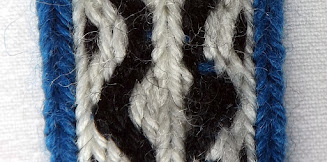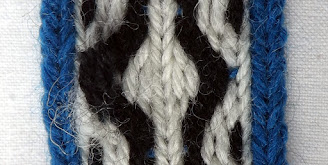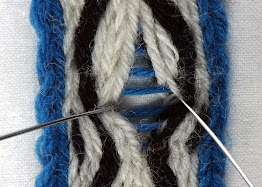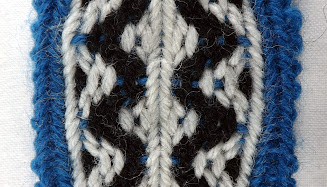On this page, we will be focusing on the effects of different weaving errors and how they come about.
We'll be using the following band and draft (made using Tablet Weaving Draft Designer) in some of the examples:
Figure 1: The band as it will look if woven based on the draft below, without any errors
Figure 2: The draft used to weave the example band
Figure 3: (left) The weft has passed over a thread it should have passed under, (right) the weft has pass under a thread it should have passed over
If the shed (the gap between the warp threads in the top two holes of the tablets and the warp threads in the bottom two holes of the tablet- see figure 5) isn't cleared properly before the weft is passed through it, the weft may skip over warp threads it should be below and pass below warp threads it should be above.
To help clear the shed, so that none of the threads are in the wrong position, hold all of the tablets together and pull them along the warp towards you for about 10cm, then push them back to their starting point. Try to be gentle if you can, as this puts the warps under extra friction and can cause damage to delicate yarns over time.
It will be harder to get a clear shed, if your tension is uneven and some warp threads are looser than others as they will tend to get pulled along by neighbouring warp threads, rather than sitting correctly. A yarn that sticks to itself will also make it harder to get a clear shed.
Figure 4: The threads on the left of the band are looser than the others because the tension across the warp isn't even
In addition to shedding problems, uneven tension can cause loose threads on the surface of the band. This will lead to those threads being affected more by wear than the rest of the band when it is in use. This is less of a problem if the band is destined to be trim, but can be a really problem in something like a belt, which takes heavy wear. You can check if some threads are tighter than others by placing your hand on the warp behind the tablets and gently strumming it like a guitar. Tension across a warp can change during weaving if some tablets are turning continuously in one direction, when others are turning both forwards and backwards. The continuously turning tablets will build up more twist behind them, increasing their tension.
If some threads are tighter than others, they may become caught on the tablets. You will need to unhook the threads before you can turn the tablets next or they will get stuck. You can often tell when a thread has become caught on a tablet, as the tablet will sit higher than the others (this is where using tablets that are all the same size as each other comes in handy).
Figure 5: The tablets controlling the selvedge on the left have been turned in the same sequence as the pattern tablets, leading to loose warp threads at each turning reversal point
To make your band stronger and longer lasting (and easy to sew on as trim), you may wish to use continuous selvedges. Every time the turning direction is changed, one or two warp threads skip over the weft, so instead of changing the turning direction of the selvedge tablets at the same time as the pattern tablets, they are turned continuously in the same direction. This will result in a build up of twist behind the selvedge tablets, but if you change the direction you continuously turn them in or flip them to change the threading direction/ warp alignment and turn them as before, the twist will gradually undo itself.
Figure 6: The weft has been beaten softly in this section, if we pull apart the warp threads (right) there's quite a bit of space between each weft
If you don't beat your weft into place hard enough (place your shuttle or an object like a ruler in the shed and pull it towards you to tighten the warp threads over the weft after every turn of the tablets) your warp threads will be loose and easily pushed apart. The resulting band won't be hard wearing and the pattern motifs will be elongated.
Figure 7: Two sections of a band that show the same pattern woven with a hard beat on the right and a softer beat on the left (from my book Tablet Weaving in Theory and Practice: Vacant-Hole Pinwheels)
If you intend to weave bands based on historical examples, you will need a very firm beat. If you are finding it difficult to beat the weft into place, your warp tension might be too high. Using a weft that is finer than the warp threads will make it easier to beat into place.
If you don't pull the weft tight enough, you may get weft bumps at the edge of your band. If you would prefer not to have these, Pull the weft a little tighter until they disappear. If they are small, they will often fade into the band over time as it is used and the warp threads change position slightly.
Figure 9: Here the weft is so loose that the warps are spread out to the point where they don't cover it properly
If you leave the weft very loose, you will see it peaking through the warp threads on the surface of the band (it's normal for a little spot of the weft to show at points where the tablet turning direction is reversed) and the band will wide, although it will be easier to beat the weft.
Figure 10: In this section, the weft has been pulled very tightly, bunching the warp threads together and making the band stiff
Conversely, if you pull the weft too tightly, the band will become narrower and the warp threads will be packed in against each other. This will result a stiff and somewhat lumpy band. You should decide how tightly you pull the weft based on the intended use of the band. A trim needs to be able to move with the garment it's sewn onto, so it needs a looser weft, while a belt needs to be stronger and more rigid so would benefit from a tighter weft.












A+ thank you!
ReplyDelete